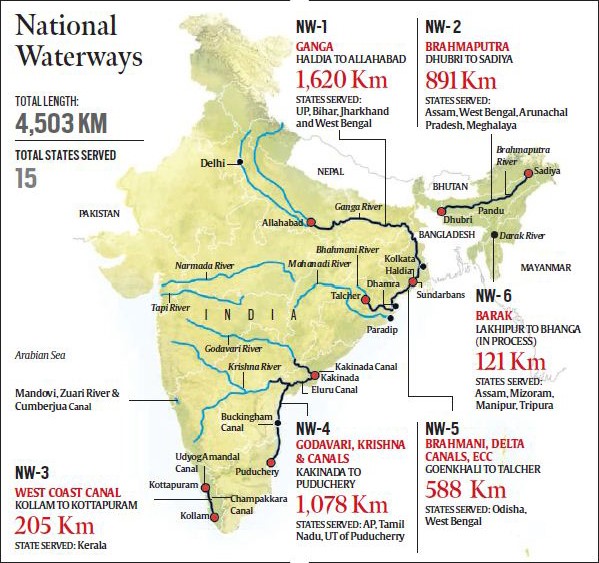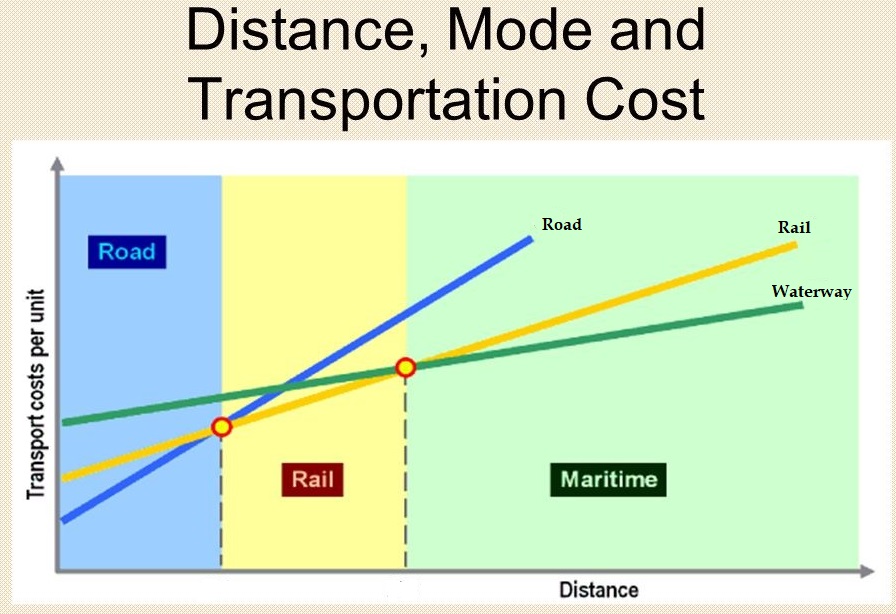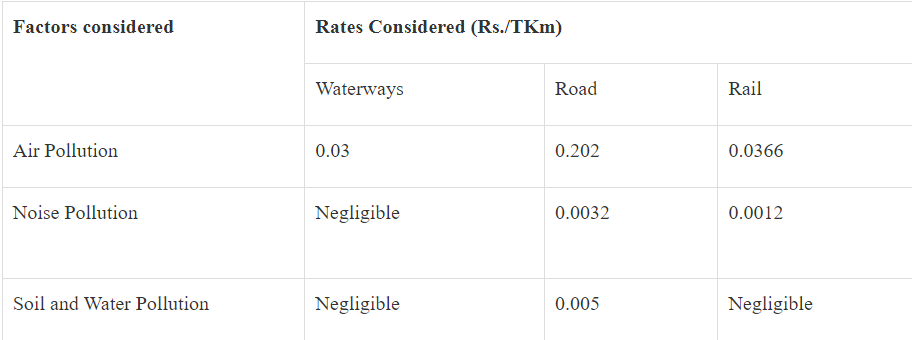Inland Waterways In India
2023 MAR 27
Mains >
Industry and infrastructure > Infrastructure & Investment models > Urban transportation

IN NEWS:
- Government intends to increase the share of IWT to 5% as per Maritime India Vision (MIV)-2030.
INLAND WATER TRANSPORT IN INDIA:
- India has an extensive network of inland waterways in the form of rivers, canals, backwaters and creeks.
- India has about 14,500 km of navigable waterways of which 4000 kms are operational.
- As per National Waterways Act, 2016, there are 111 National Waterways in the country.
- About 55 million tons of cargo is being moved annually by Inland Water Transport.
WHY ENCOURAGE WATER TRANSPORT?
- Low capital cost:
- The development cost of inland water way is less when compared with the equivalent development cost of railway and four lane expressways, as it involves nominal land acquisition and infrastructure.

- Reduce logistics cost:
- As per a study carried out by RITES, one litre of fuel will move 24 tons through one kilometre on road, 95 on rail and 215 kilometres on inland water transport. Hence, IWT can reduce the cost of logistics.
- Other studies support this finding:

- Improve India’s competitiveness:
- The current logistics cost of India is 14 % of GDP, while in the US and Europe, it ranges between 8-10%. This reduces competitiveness of Indian exports in the international markets. By developing Inland transport, India can reduce the logistics cost and enhance competitiveness.
- Less polluting mode of transportation:
-
- Water transport is among the least polluting modes of transport.

- Reduce burden on other modes:
- India has an unbalanced logistics modal mix. Road transport carries ~60% of total freight movement while IWT remains under utilized at a share of 2% in India’s modal mix. Development of IWT can help resolve this issue.
- Facilitate regional development:
- Movement of goods and passengers through inland waterways necessitate setting up large number of loading/unloading points. This facilitates the creation of infrastructure and diffusion of information into India’s hinterlands, leading to their development.
- Eg: Varanasi multi-modal terminal, with its rail, road and waterways connectivity is being developed to boost the growth of Uttar Pradesh’s hinterlands.
- Development of North East India:
- India has agreements with Bangladesh and Myanmar that facilitate transshipment of goods through Bangladesh and Myanmar waters. Developments on these lines will enable quicker shipments and deeper market penetration to the North Eastern parts of the country.
- Promote employment:
- IWTs can generate employment in the country. Eg: Tourism and fisheries could expand to the inland areas of the country and create alternate sources of income for the people.
GOVERNMENT EFFORTS:
- Inland Waterways Authority of India (IWAI):
- To harness the potential of IWT, Inland Waterways Authority of India (IWAI) was established in 1986.
- The Authority primarily undertakes projects for development and maintenance of IWT infrastructure on national waterways through grant received from Ministry of Shipping.
- It is headquartered at Noida with regional offices at Patna (Bihar), Kolkata (West Bengal), Guwahati (Assam) and Kochi (Kerala)
- National Waterways Act, 2016:
- The Act repealed the five Acts that declared the national waterways 1 to 5. These five national waterways are now covered under the Act.
- It also provides for the regulation and development of waterways for the purposes of shipping and navigation.
- Jal Marg Vikas Project (JMVP):
- It aims at capacity augmentation of navigation on National Waterway-1 (NW-1), along river Ganga.
- It is being implemented at a cost of Rs 5369.18 crore with the technical assistance and investment support of the World Bank.
- Jal Marg Vikas Project -II (Arth Ganga) for NW-1:
- ‘Project Arth Ganga’ envisages to re-engineer the JMVP by involving the local community with a focus on economic activities in and around the Ganga River.
- About 40 floating jetties and 10 pairs of Ro-Ro terminals are being planned on River Ganga in the four states in the Gangetic belt, which will bring down the logistics cost for farmers in the movement of local produce.
- Inland Vessels Act, 2021:
- The Act replaced the Inland Vessels Act, 1917. It introduced a uniform regulatory framework for inland vessel navigation across the country.
- It provides for a central database, brings transparency and accountability of administration of inland water transportation, strengthen procedures governing inland vessel construction, registration, manning and navigation.
- Development of New National Waterways:
- IWAI has identified 25 new NWs through techno-economic feasibility studies for undertaking technical interventions to make the waterways navigable for transportation purpose.
- Digital solutions for ease-of-doing business:
- CAR-D (Cargo Data) Portal:
- It is a web-based portal for collection & compilation, analysis and dissemination of all cargo and cruise movement data of National Waterways to the stakeholders.
- PANI (Portal for Asset & Navigation Information):
- PANI is an integrated solution brining river navigation and infrastructure information on a single platform.
- Other initiatives:
- Promotion of private participation in terminal operations and maintenance.
- Proposals to link national waterways to the eastern and western Dedicated Freight Corridors (DFCs), as well as the Sagarmala Project are in the pipeline. The linkages are being planned such that cargo can be swapped/shifted from and to the waterways, the DFCs and road transport.
CHALLENGES:
- Hydrological challenges:
- The depth of most waterways is not uniform throughout the year. Siltation and the seasonal variations in regime of rivers do not offer navigability through the year.
- Eg: One of the major problems for a commercially viable and safe navigation on NW-1 is low depth upstream of Farakka due to low discharges from tributaries and difficult hydro morphological characteristics of river Ganga.
- Ecological concerns:
- Riverine systems in the country are home to an array of endangered fauna, like the riverine dolphins, Gharials and migratory birds. Activities like dredging and dumping from vessels could pose challenge to these ecosystems.
- Competing needs:
- Water has important competing uses, viz. need for living as well as for irrigation, power generation etc. There is also the issue of interstate water disputes.
- Eg: Diversion of water for irrigation by upper riparian state can reduce the navigability in the lower riparian states.
- Overlapping jurisdiction:
- In the Constitution, water is a matter in the State List, subject to the provision of Entry 56 of Union List (Related to regulation of inter-state rivers).
- Also, Central government has exclusive jurisdiction only on national waterways, whereas the utilisation/sailing of vessels in other waterways is within the concurrent list or is in the jurisdiction of the respective state governments.
- Last mile connectivity:
- Inland water transportation is not as flexible as roads and railways. They can be carried out only on rivers with sufficient volume of water and waterfront locations. Hence, they require integration with other modes for last mile connectivity.
- Operational challenges:
- The 111 waterways require capital investments for development of basic infrastructure and maintenance through dredging for their proper utilization. There is also the shortage of inland vessels and non-availability of return cargo.
WAY FORWARD:
- Coordinated strategy:
- A tailor-made policy for promoting waterways network should be developed. This policy should include well-defined institutional mechanisms, promote private investments and facilitate inter-state and centre-state collaborations, among others.
- Individual studies:
- Every riverine system is unique and presents diverse challenges. Hence, separate studies to assess viability need to be done for each, before taking up implementation.
- Complementarity with other modes:
- An integrated transport network, comprising of Inland waterway, roadways, wail and coastal shipping, needs to be developed to realize the full potential of India’s waterways.
- Augment manufacturing capability:
- India has the know-how on developing vessels and other systems needs for Inland water transport. But this needs to be enlarged to meet the growing needs of country. Joint ventures and PPP models may be considered for the same.
CASE STUDY: Germany’s Inland Waterways
- The Federal waterway network in Germany comprises about 7,350 kilometres of inland waterways, of which roughly 75 % are rivers and 25 % canals.
- The main freight inland waterway network includes the Rhine and its tributaries, the Danube, sections of the Weser, Elbe and Oder.
- These waterways form the connection to and from the German seaports to ensure maritime transport operations.
- Up to 240 million tonnes of bulk goods are transported per year via the German Federal waterways. 56 of the 74 metropolitan areas in Germany are linked via waterways. German inland shipping and inland ports keep around 400,000 people in work.
- In addition, inland passenger vessels, including river cruise ships, are also utilizing the waterways and contribute to the country’s tourism sector.
PRACTICE QUESTION:
Q. Examine the prospects and challenges of inland water transport in the country.



